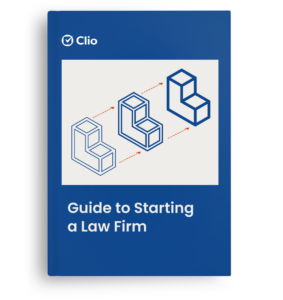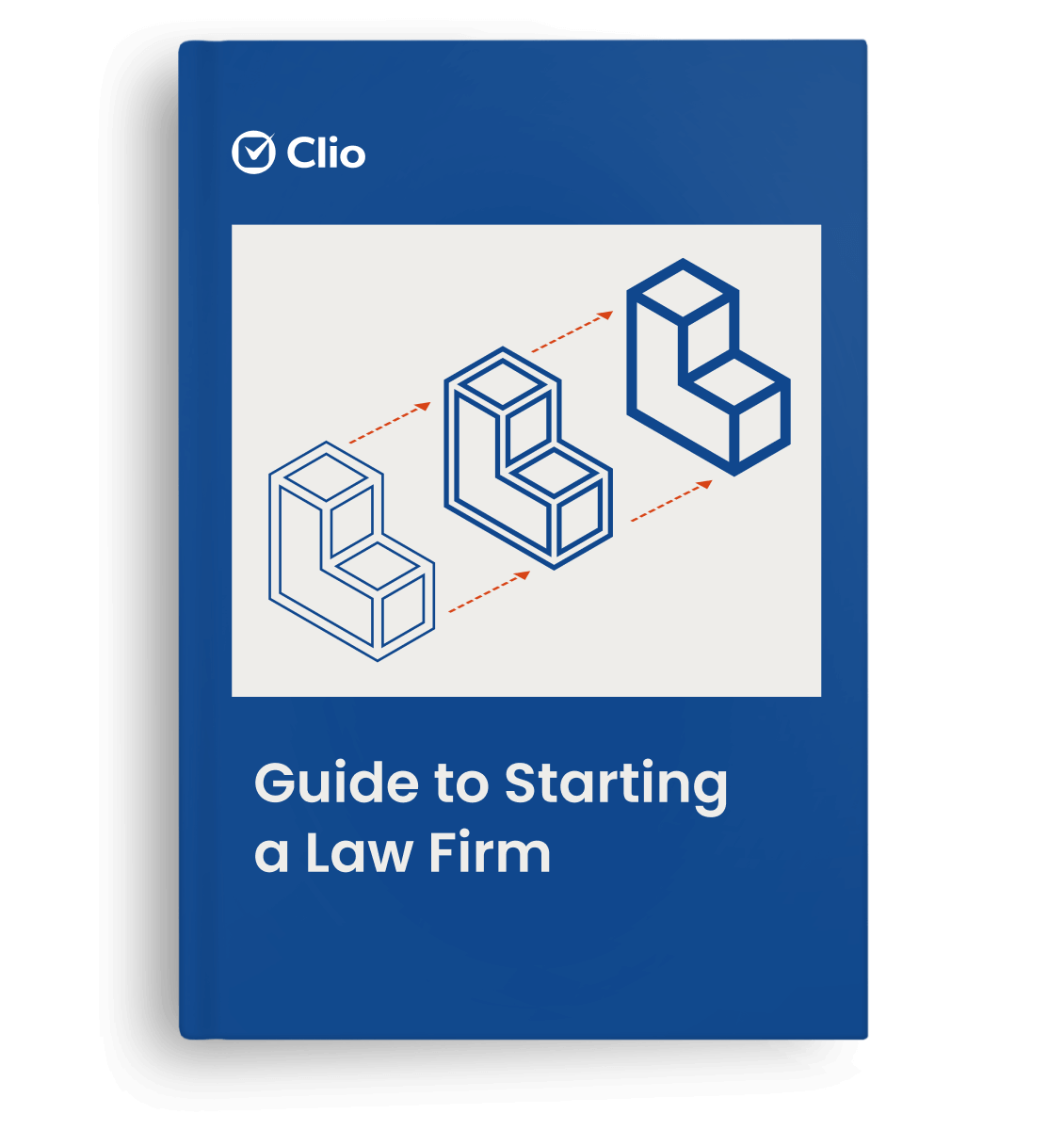If you’re wondering how to manage a small law firm effectively, you’re not alone. Managing a small firm poses unique challenges to legal professionals compared to Big Law, where admin staff performs many of the day-to-day tasks. In most smaller firms, those admin tasks fall on the shoulders of the attorneys and paralegals. This takes time away from billable and direct client work to be the “chief, cook, and bottle washer.”
Your firm must be extremely nimble and adaptable to change and keep up with the latest industry trends and developments—to make sure your legal practice does not fall behind.
In this blog post, we’ll cover how to effectively manage a small law firm, by focusing on key aspects of your firm: staff, client experience, financials, technology, and brand. We’ll also include tips on how to manage your team to set you and your team up for success.
Rethink your pricing and payment models

When thinking about managing a small law firm, it’s important to go back to basics and reevaluate your pricing and payment models. The 2020 Legal Trends Report found that clients care about affordability. In particular, 78% of consumers say that lawyers should adopt pricing and/or payment models that will make legal services more affordable. But lawyers should look at the issue of affordability across multiple dimensions. “Affordable” is more than just about the overall price. It’s about the value your clients perceive they have received for the price they have paid. How many times have you happily paid extra for something knowing you were getting excellent customer service? At the same time, how often have you paid less and been less than pleased with the results?
For example, for many years my optometrist was also my supplier of contact lenses. While I knew I could get them cheaper at the big-box stores, I also knew I always got excellent service and valued my relationship with the optometrist. Over the years, he helped me in various ways that had value but no price. When the optometrist retired and I went to see a new one in a bigger company, there was no comparison to the customer service–I couldn’t even get someone to call me back to place an order! Off to the big-box store I went, having lost the incentive to continue with the new provider.
Go beyond reducing prices or offering discounts for your legal services
Reducing prices or offering discounts is a short term solution. There is often a race to the bottom that is hard to compete with, especially against larger law firms with more resources and profit margins to work with. It can also condition your clients to always expect or ask for a discount. Think about it: Would you ever go into Bed Bath and Beyond without a 20% off coupon? This strategy can easily backfire and devalue your work—in the eyes of your clients.
To quote Seth Godin, a well-known author, speaker, pricing and marketing expert, as well as a recent keynote speaker at the 2020 Clio Conference: “The reason it seems that price is all your customers care about is that you haven’t given them anything else to care about.” His blog article about the Tyranny of Lowest Price speaks very clearly about the costs of lowering prices. “The problem with the race to the bottom is that you might win. Even worse, you might come in second.”
Offering different pricing models for your legal services can be a great way to package certain services in a way that’s more affordable, without a discount price tag.
Hire the right staff with the right roles to improve productivity

In a smaller law firm, one team member can make an oversized impact on your firm. Surprisingly, small firms often make the mistake of hiring receptionists and staff with poor people skills. In my 20 years of consulting with law firms, it is unfortunately not unusual to have staff answer the phone in a less-than-friendly manner and ask someone to call back rather than take a message. These are not only your office gatekeepers but should be known as “Director of First Impressions”. Having staff who not only share your firm’s vision but also are on board with making it into a daily reality is crucial to your firm’s success.
Delegating administrative and non-billable work is also key to making the best of the most limited resource you have—time. When attorneys and paralegals can focus on client work with fewer distractions and interruptions, they can be more effective, productive, and profitable.
Another way to improve productivity is to have your staff specialize in specific tasks and areas of work. It is common in smaller law firms for a single staff member to be the office manager, billing coordinator, paralegal, and occasional receptionist. This is understandable, given the smaller headcount. However, outside bookkeepers, receptionists (or virtual receptionists), and team members who are experts at specific tasks can often perform their work more efficiently and sometimes at a lower cost.
With a more productive team at your firm, you can save time and ultimately—money.
You may like these posts
Focus on relentlessly improving the client experience
Meet clients where they want you to be—online

As our world becomes increasingly digital, client expectations are shifting. The 2021 Legal Trends Report shows, clients want to be able to interact with their lawyers online, with 79% of clients saying they’re more likely to hire a lawyer that offers virtual meetings.
Clients interact with law firms and lawyers online through multiple touchpoints—through an initial review of a clear and engaging website, easy client intake process, e-signing documents, or online access to a client portal with key information related to their case. When a client can access the information they need with ease and minimal friction, they will have a more positive experience.
Reduce friction in payment options by offering payment methods that clients want
According to the 2021 Legal Trends Report, 66% of consumers prefer to pay online. Offering your clients more digital ways to pay for legal services also helps decrease friction for clients by making it easier for them to pay.
Improve and streamline your small law firm’s billing process

To start improving your small law firm’s billing process, here are some questions to ask:
- Is your billing process spelled out clearly at the beginning of the client engagement?
- Does your firm provide easily understood invoices at reasonable intervals?
- Have expectations been set appropriately?
Ideally, clients should never be surprised by the billing process or the amount on their invoices. Lack of attention to these items can result in uncollectible work and unhappy clients—both of which can be devastating in a small firm.
Too often, law firms will take a retainer and not produce an invoice until the retainer has been used up. The results in their client receiving a shock because they were unaware of the cost of the legal services that had been provided thus far. While working with an attorney recently, they mentioned that the client was going to be upset at the size of the bill. Whether it was due to the length of time since their last invoice or the amount of work completed, if you feel that a client will be shocked at the bill, be sure to communicate along the way to improve the client experience.
Learn more about using evergreen retainers at your law firm.
Learn how to manage a small law firm better by getting a grip on your firm’s financials

When managing a small law firm, it’s essential to have a clear understanding of your firm’s financials. Law schools are notorious for training lawyers who know the law but not how to manage their firm—especially their law firm’s finances. While you do not need to be an accountant, understanding key metrics is vital to making decisions for the firm. And it’s beneficial for any practice areas that your firm covers.
- Work In Progress (WIP): How many hours/work has your firm captured but not yet billed? While not always a collectible amount, this gives you an idea of the potential upcoming billings. If your firm has hourly arrangements, it is also crucial to know how “old” the time is (i.e. Aging). Once the time is more than 60 days old, it can be harder to invoice.
- Accounts receivable (A/R): Work that has been billed but not yet collected. Again, the Aging of the Accounts receivable will be critical to the collections process. Once an invoice is over 60 days old, the chances of collecting in full drop steeply.
- Collectible: Knowing how many hours your law firm has captured, billed, and collected at any one time will help you to understand your actual realization rate.
- Trust accounts: Do you know the trust balance for all of your client matters? Are the accounts reconciled according to your State Bar Rules?
Reviewing the above periodically (at least monthly) will help you understand and address issues before they become critical. This lets you address issues and bill clients whose work has been completed and review outstanding A/R to identify accounts that might need more aggressive collections.
Run your small law firm virtually with a cloud-based legal practice management software

With the increased shift towards working remotely, cloud-based legal practice management software has seen explosive growth in the last several years. This allows firms to operate and serve clients, even in an unexpcted disaster like a fire or flood.
Technology adoption can influence small law firm performance dramatically—including improving resilience during times of crisis. It shifts the focus back on solving clients’ problems rather than getting caught up in redundant and often time-consuming administrative tasks.
Grow your client base with cloud-based client intake tools

Legal client intake tools like Clio Grow can help you create a reliable and streamlined intake process easily and practice more efficiently. Client intake tools can help take your client from intake to engagement, along with specific follow-up tasks to make sure each inquiry has the proper timing and amount of follow up. These tools also allow your law firm business to get organized and market your services to an already interested audience.
Learn more about how to improve your law firm’s client intake process and automate your client intake process.
Organize your small law firm efficiently
In addition to the above points, managing a small team in a law firm has its unique challenges. Here are key ways to manage a small team effectively:
Prioritize What Matters
More often than not, we get caught up in everyday, trivial things that it’s easier to forget the bigger picture. Knowing what’s important to your law firm helps anchor your business and team whenever things are getting out of hand.
The focus should always be on the clients, delving more into client work and less on tasks that can be overhauled, automated, or maybe even avoided.
Like Stephen R. Covey rightly said, “Most of us spend too much time on what is urgent and not enough time on what is important.”
Create procedures for everything
For many attorneys who leave a larger firm to start their practice, they are immediately overwhelmed by the sheer amount of “trivial” work that they had no idea how to complete. This includes everything from e-filing court documents to handling the various licensing and bar requirements. In one conversation with a client recently, he shared how amazed he was to learn about the work that entire departments did (i.e. billing, HR, admin) that he had no idea about until he started his firm. And this is not just a one-off occurrence. It’s more common than you think in small law firms.
Create a system for anything that you do more than once. It is easier to delegate and repeat when the process is defined and easily followed. As Mike Michalowicz writes in his book, Fix this Next, Make the Vital Change That Will Level Up Your Business, “When you bring order to your business, you give it autonomy, because the company is no longer dependent on any individual (including you). It has balance, strength, and fluidity. You are no longer carrying the business on your back, which means your company can continue without you – for a few days, or weeks, or years or a lifetime.”
Without a clearly defined process, you and your staff can easily miss steps. As Atul Gawande, MD, MPH, a surgeon, writer, and public health researcher writes in Checklist Manifesto: How to Get Things Right, “Checklists seem to protect against such failures. They remind us of the minimum necessary steps and make them explicit. They not only offer the possibility of verification but also instill a kind of discipline of higher performance.” Procedures are also important for cross-training your staff and onboarding new staff. Examples of procedures in a small law firm include routine tasks like billing, payments, document management, client services, marketing, etc.
Learn more tips on how to get organized as a lawyer.
Streamline your processes
Once you have documented your procedures, it’s time to examine your processes (both manual and technology) to avoid duplicating your efforts. No matter your practice area, capitalizing on technology will enable you to spend less time on routine and repetitive manual tasks, like document creation. The more often (or places) you need to enter the same information, the more likely you will have mistakes. By automating wherever possible, small law firms will be more efficient and therefore profitable.
Learn more about document automation to help you save time and avoid error.
Leverage the technology available

Review potential integrations between software programs to expand functionality and reduce extra work. Be it marketing, business development, e-discovery, or reporting, chances are that there are integrations available for many firm functions to perform better as a unit.
One of my law firm clients realized that the time it took to add contact information in both his case management system as well as his VOIP phone system was wasted and introduced not only extra lag time but also possible errors. We enabled a link between the two programs and it had an immediate impact on his functionality. In Clio, you can use the Vonage integration for a similar function. Now, once a new contact was entered into his phone contact list, it was also synced to his phone system. This allowed him to make and receive calls directly from his phone system.
One of the best advantages of leveraging technology we often forget is that it helps build scalable systems. As the firm and the client base grows, the complexity of managing a firm increases exponentially. Adopting technology helps in mitigating manual errors and building systems that work no matter the client or team size.
Invest in training your team
One of the most overlooked components of working with a team to implement new strategies, processes, and technology is training. How often do we expect our team members (or ourselves) to learn as we go, or in some ad hoc fashion?
Think of training as an asset, not an expense. This is an investment in not only being productive but also preventing costly mistakes. I’m often called in to address common mistakes that occurred because staff did not understand how to implement software. “You can hire me to teach someone to do it right, or you can hire me to fix it.” The latter is much more time consuming and expensive, as we must not only isolate and resolve the problems but also properly retrain staff.
The good news is that there are more resources than ever available for training. Be it lawyer training in different practice areas, business development, or even goal setting for instance. There are as many formats available as there are learning styles, including videos, one on one or group training, mentorship, conferences, articles and manuals, e-books, etc.
Provide training for your staff so they can be more efficient, and effectively use the technology and processes that you have. Make sure that staff is cross-trained if needed, and ideally have all staff attend relevant training.
As Richard Branson said, “Train people well enough so they can leave, treat them well enough so they don’t want to.”
Most importantly, be involved in the training process, or at the very least do not interrupt it! Giving your team space and time to learn is crucial. I can’t tell you how often during a training session a staff person is interrupted to address other work. This breaks their focus and clearly shows the priorities of the “now” are less than the knowledge for the future.
Learn more about training for lawyers.

You’re ready to start managing your small law firm effectively
Small law firm management is simultaneously challenging and advantageous. However, focusing on the big picture and the critical details will help fuel your growth. Level up your client-centered experience while optimizing internal processes with practice management software. Try Clio today.
We published this blog post in November 2020. Last updated: .
Categorized in: Business








